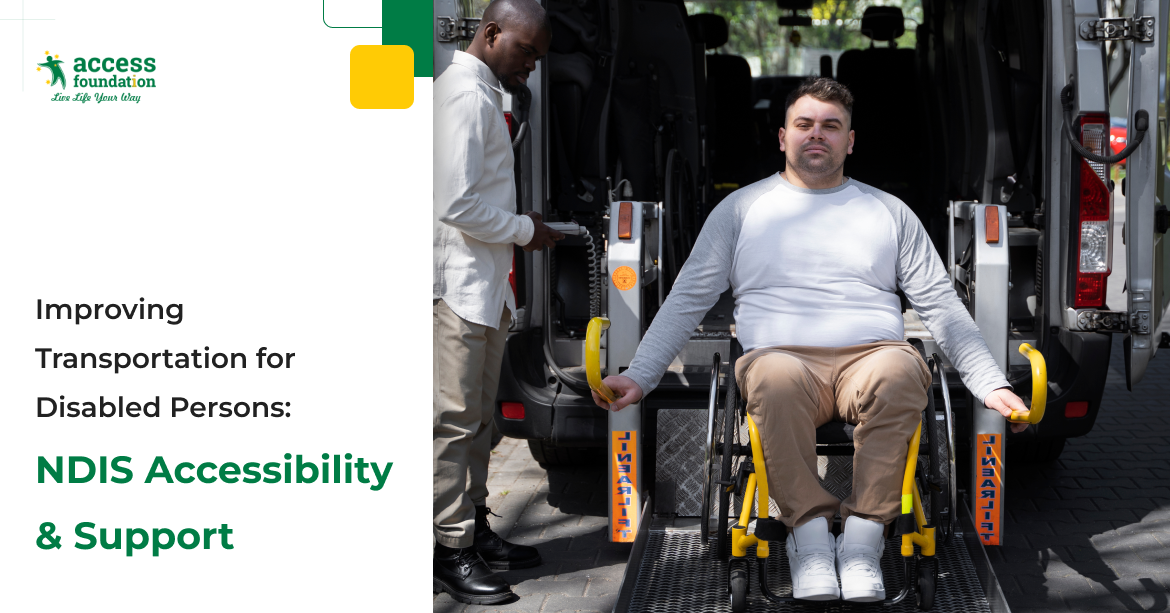
Improving Transportation for Disabled Persons: NDIS Accessibility & Support
NDIS Transportation for Disabled Persons are a lifeline for thousands of Australians with disability. And why not? Getting around is a daily challenge when you live with a disability. Buses and trains aren't always accessible, and not every suburb has the right options. In contrast, access to safe, reliable, and accessible transport empowers NDIS participants to attend appointments, work, social events, and live more independently.
In this guide, you'll discover how NDIS Transportation for Disabled Persons work, what funding is available, common challenges and solutions, how to pick the right provider, and practical tips to maximise your support.
What is NDIS Transportation Support?
NDIS transport services provide funding and assistance for people who struggle to use standard public transport because of their disability. This support can take many forms, such as allowances for taxis, community car services, or vehicle modifications. Participants might use this funding to get to and from work, school, therapy, or social events.
Who is eligible?
You may be eligible if:
Your disability means you can't use public transport without significant difficulty.
You're not already receiving a government mobility allowance.
You need regular travel to work, education, or community events.
Important: Usually, NDIS doesn't fund a support worker's travel time unless specified in your plan.
Common Barriers in Disability Transportation
Transportation for Disabled Persons remains tough in many parts of Australia. Let's look at some real, common challenges:
Public Transport Gaps: Not every bus, cab, or train is wheelchair-accessible. In regional NSW, accessible bus routes are often limited to main towns, leaving residents in smaller communities without viable options.
Wheelchair-Accessible Vehicles Are Scarce: There aren't enough vehicles with ramps, lifts, or space for mobility aids, especially in rural areas.
Driver Training: Not every driver is trained in first aid or proper disability support, which makes trips uncomfortable or unsafe.
Booking Drama: Community transport is often overbooked. Waiting lists are the norm in some suburbs or towns.
Provider Confusion: Some drivers, taxi companies, or rideshare services don't understand how the NDIS Transportation for Disabled Persons works or how to process payments.
Rural Struggles: In WA, towns may have very few service options. Some people rely on friends or family for all their travel needs.
What Makes an NDIS Transport Provider Reliable?
Partnering with the right NDIS registered provider is key to staying safe and independent, especially in the Transportation for Disabled Persons segment. So when you decide to pick the right one, consider the following points for an error-free choice:
NDIS Registration: Always choose a provider officially registered with the NDIS for added protection and approved funding use.
Accessibility: Vehicles should have ramps or lifts, secure restraints, and room for wheelchairs or other assistive devices.
Skilled Drivers: Drivers trained in first aid and disability support make a world of difference.
Easy Booking and Tracking: Look for apps or systems that let you book in advance and track your driver in real time.
Reputation: Check reviews, testimonials, or word of mouth from your area; local knowledge counts.
Coverage: Make sure the provider serves your neighbourhood and offers both routine and last-minute trips if needed.
How to Use Your NDIS Funding for Transport
NDIS Transportation for Disabled Persons funding is designed to be flexible, but the right steps help you get the most from your plan.
Find Funding in Your NDIS Plan: Transport funding, if approved, is listed under "Core Supports." Check your plan summary for a dedicated line item for transport.
Know the Levels of Support
- Level 1: Occasional trips for people with part-time needs.
- Level 2: Regular needs, e.g., weekly appointments.
- Level 3: Daily, frequent travel for work/study.
Booking Your Ride: You can pay for community buses, wheelchair taxis, or accessible rideshare vehicles. Choose an NDIS registered provider for direct NDIA payment or pay out of pocket and submit invoices if you self-manage.
Track Your Trips: Use a transport log, app, or spreadsheet to record each trip. Many providers supply digital records, which makes claiming simple.
Claiming Rides: Submit your invoices through Myplace, your plan manager, or your support coordinator. Keep receipts. For community and private transport, apps can automate much of this process.
Management Types
- Agency-managed: NDIA pays automatically.
- Plan-managed: Your manager pays providers.
- Self-managed: You arrange everything and then claim back the amount.
Best Practices for NDIS Transport Support
Getting the best out of your disability transport NDIS budget is not difficult. You only need to follow these tips to get desirable results:
Book Early: During peak hours or special events, book in advance to avoid heavy traffic and missing out.
Keep Records: Maintain a simple transport log! Note down trips, providers, and costs. This makes your next NDIS plan review a breeze.
Use Technology: Download NDIS-approved apps or tools to keep track of travel and book rides easily.
Coordinate with Support Workers: Align travel needs with your support worker's schedule for smooth routines.
Review and Adjust: Speak with your plan manager about your transport usage every few months. In case you need to adjust your budget or request changes, bring it up during your annual review.
Ask for Help: The best thing you can do is reach out for help! Don't hesitate to ask your provider, support coordinator, or even a peer for advice.
How Technology and Accessibility are Making Transportation Under the NDIS Better
Disability transport under the NDIS is changing, thanks to new technologies like AI and more. Here's a look at what's making things more accessible right now and what we can expect moving forward.
Smart Booking Apps: Book accessible vehicles or rides at the tap of a button, with options tailored for NDIS participants.
Real-Time Tracking: Live GPS tracking keeps everyone in the loop. It means no more waiting out in the rain for your ride.
AI Scheduling: Apps that learn your regular needs and suggest the best travel times.
Adaptive Vehicles: Modern wheelchair-accessible vehicles now include ramps, automatic doors, and voice controls.
Future Trends: Autonomous vehicles could soon offer even more freedom for people with disabilities. Integration with wearable tech, like GPS-enabled aids, will help you travel safely and independently.
Final Takeaway
When you are struggling with any type of disability, accessible, safe transport is your wings to the daily hustle and freedom. NDIS transportation services are opening doors for thousands of Australians, giving people the freedom to connect, learn, and work without barriers. If you or someone you know needs help with disability transport NDIS, talk to your coordinator, check your plan, or reach out to Access Foundation, a reliable NDIS service provider for personalised Transportation for Disabled Persons.
FAQs
Q1. What kinds of Transportation for Disabled Persons does the NDIS pay for?
Ans: The NDIS can help with the cost of accessible taxis, rideshare services, community buses, and even adapting your vehicle, if using public transport just isn't an option for you.
Q2. Can I use NDIS funding for Uber or taxi rides?
Ans: Absolutely, but there's a catch. You need to have transport funding already approved, and the specific ride must meet the NDIS's rules about accessibility and compliance.
Q3. Is there a limit to transport funding?
Ans: Yes. Funding is level-based, depending on your travel needs and what's in your plan.
Q4. Do I need to be plan-managed to access transport services?
Ans: No, all management options (self, plan, agency) can access transport processes; they just differ.

